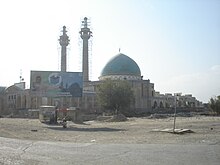
Afghanistan is divided into 34 provinces. The provinces of Afghanistan are the primary administrative divisions. Each province encompasses a number of districts or usually over 1,000 villages.
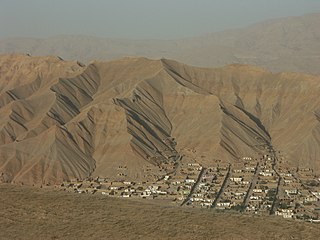
Baghlan is one of the thirty-four provinces of Afghanistan. It is in the north of the country. As of 2020, the province has a population of about 1,014,634.

Islam in Afghanistan began to be practiced after the Arab Islamic conquest of Afghanistan from the 7th to the 10th centuries, with the last holdouts to conversion submitting in the late 19th century. It was generally accepted by local communities as a replacement of Zoroastrianism and Buddhism, local tribes began converting to the new religion. Islam is the official state religion of Afghanistan, with approximately 99.7% of the Afghan population being Muslim. Roughly 90% practice Sunni Islam, while around 10% are Shias. Most Shias belong to the Twelver branch and only a smaller number follow Ismailism.

The Aga Khan Development Network (AKDN) is a network of private, non-denominational development agencies founded by the Aga Khan, with the primary focus of improving the quality of life in different regions of Asia and Africa.
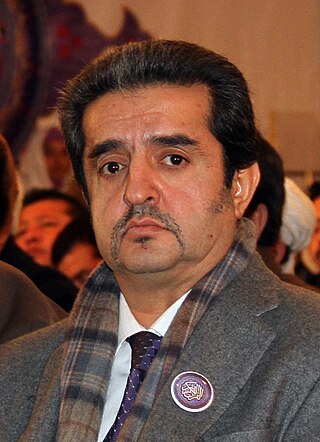
Sayed Jafar Naderi is an ethnic Tajik-Ismaili who controlled Baghlan Province of Afghanistan during the early 1990s. He was born in Kayan, Baghlan and is also known as Sayyid-e Kayan The son of Sayed Mansoor Naderi, The previous Vice-President of Afghanistan, Sayed Jafar Naderi went to school in England at age 10, after his father was made a political prisoner. He was sent to the United States at age 13 where he became known as Jeff Naderi.
The following lists events that happened during 2002 in Afghanistan.
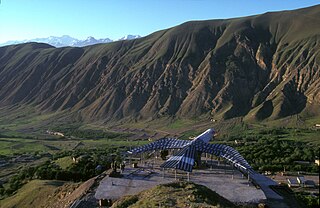
Kayan is a village in Baghlan Province in north eastern Afghanistan It is located in the valley of Kayan, some 30 kilometres west of Dushi. The residents of Kayan valley are mostly members of Sadat and Hazara tribes loyal to Sayed Kayan who was the official representative of Aga Khan in Afghanistan. The Sayyids follow Isma'ili Islam.

The Tajik–Afghan bridge at Tem-Demogan was opened on 3 November 2002. It spans the Panj River. It was the first of four bridges planned to be built with the assistance of the Aga Khan Foundation.

Sayed Kayan or Sayed of Kayan is a title in northern areas of Afghanistan. A part of the Ismaili community in Afghanistan was led by a family of Syeds hailing from the village of Kayan.

Sayed Mansur Naderi is a leader of an Ismaili Shi'a community centred in Baghlan Province of Afghanistan. This community although Shia is smaller than the mainstream Twelver Shia community in Afghanistan.

Kabul Serena Hotel is a luxury hotel in downtown Kabul, Afghanistan.
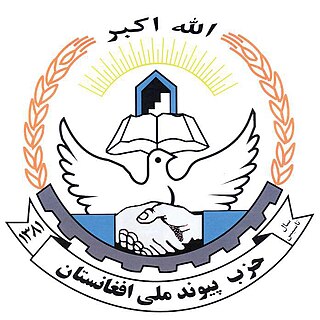
The National Solidarity Party of Afghanistan or some other places written as National Unity Party of Afghanistan is a political party representing the Afghanistan's Ismaili Shia minority, largely found in Kabul Province, Baghlan Province, Bamyan Province, Balkh Province and Badakhshan province. As recently as 2008 it was one of 84 political parties registered with the Afghan Ministry of Justice, and headed by Sayed Mansur Naderi.
The Imamate in Nizari Isma'ili doctrine is a concept in Nizari Isma'ilism which defines the political, religious and spiritual dimensions of authority concerning Islamic leadership over the nation of believers. The primary function of the Imamate is to establish an institution between an Imam who is present and living in the world and his following whereby each are granted rights and responsibilities.
The 6th Corps was a corps of the Afghan Army, seemingly active from 1990 to around 2003–2004. Created as a military formation of the PDPA's standing army, it degraded into a grouping of militias by its last years.
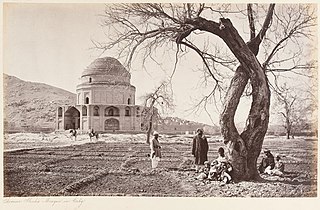
The tomb of Timur Shah Durrani is located in Kabul and was built in 1815. It is the mausoleum of Timur Shah Durrani, who was the second ruler of the Durrani Empire, from 1772–1793. In 1776 Timur Shah chose Kabul as the capital of Afghanistan, which was Kandahar until then. Although he died in 1793 in Char Bagh, it wasn't until years later that the tomb was built. Timur Shah was later buried in here.

Khushnood Nabizada is an Afghan journalist, diplomat, peace campaigner, and entrepreneur. He is the founder and owner of Khaama Press, an Afghanistan-based news agency that reports specific political issues of the Afghanistan region.

Sayed Sadat Mansoor Naderi is an entrepreneur and politician. He was Afghanistan's State Minister for Peace from 2020 to 2021 and Minister of Urban Development and Housing from 2015 - 2018.

The world's largest handmade Quran was unveiled in Kabul, Afghanistan in 2012. It was crafted by Afghan calligrapher Mohammed Sabeer Khedri Hussani and his team.

Rawnaq Naderi also known as Sayed Nooruddin Rawnaq Naderi was a distinguished Afghan poet whose works have contributed significantly to Persian literature. As the son of Sayed Kayan, a prominent religious leader of the Afghanistan Ismailis, Naderi's upbringing was deeply influenced by a rich cultural and religious environment.

